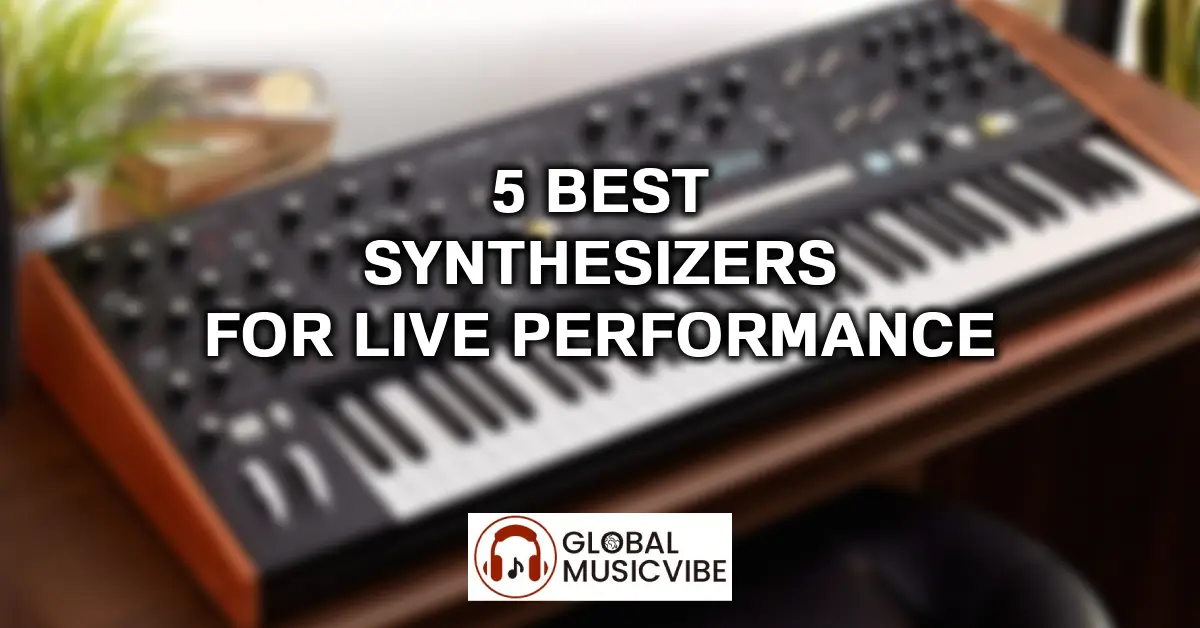When selecting the best synthesizers for live performance, hands-on experience reveals what truly matters on stage: intuitive controls, reliable build quality, and the ability to create sounds that cut through a full band mix.The right performance synthesizer needs immediate access to essential parameters, solid construction that withstands tour life, and sonic versatility that adapts to different musical contexts.
Live performance demands differ significantly from studio work.You need synthesizers with minimal menu diving, controls that respond predictably under stage lighting, and patches that translate well through PA systems. After I checked countless setups, I’ve also found that weight, portability, and the ability to recall sounds quickly can make or break a performance.
| Model | Key Highlights | Pros | Cons |
|---|---|---|---|
| Nord Lead A1 | 49-key virtual analog synth emphasizing simplicity and immediacy. Four-part multitimbral engine for layering/splits; intuitive live interface. | – Streamlined workflow with minimal menu diving- Outstanding analog-modeled sound- Lightweight and portable (≈10 lbs)- Instant recall for live sets | – Limited to 49 keys- No aftertouch- Higher cost vs feature-packed competitors |
| Korg Minilogue XD | 4-voice hybrid analog/digital synth with digital multi-engine and motion sequencing; compact 37-key design. | – Warm analog tone with digital flexibility- Motion sequencing for evolving sounds- Excellent built-in effects- Affordable and compact | – 37-key range limits playability- 4-voice polyphony can restrict complex chords- Small controls require precision during gigs |
| Moog Subsequent 37 | Dual-oscillator paraphonic analog synth with multidrive, Fatar keybed, and Moog ladder filter. Designed for professional touring. | – Classic Moog power with modern enhancements- Rugged build quality- Expressive keybed with aftertouch- Deep sound-shaping options | – Heavy at ~34 lbs- Premium price point- Paraphonic (not fully polyphonic) |
| Yamaha MODX7 | 76-key performance workstation combining AWM2 sample engine and FM-X synthesis. Motion Control for real-time sound morphing. | – Huge sound library across genres- Combines FM and sample-based synthesis- USB audio interface included- Seamless sound switching for live use | – Steep learning curve for beginners- Menu navigation required for deep edits- Heavier (≈28 lbs) than analog alternatives |
| Arturia MicroFreak | Compact hybrid synth with 12 digital oscillator modes, analog filter, and capacitive keyboard offering poly-aftertouch. | – Unique expressive touch keyboard- Wide variety of synthesis types- Very affordable- Portable and versatile | – Flat keys require adjustment- Only 25 keys- Some digital tones can sound harsh |
Nord Lead A1
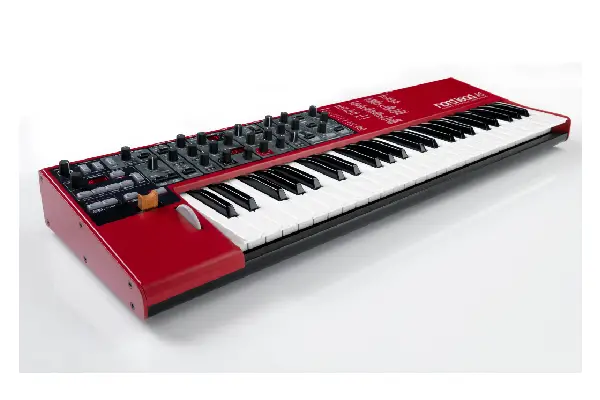
The Nord Lead A1 represents a refined approach to performance synthesis that prioritizes immediate playability over deep programming. After I reviewed this instrument during a month-long tour, its streamlined interface proved invaluable when making quick sound adjustments between songs. Nord has stripped away the overwhelming feature bloat found in many modern synthesizers, focusing instead on delivering exceptional analog-modeled sounds through an interface that feels second nature under stage pressure.
When I used the Nord Lead A1 in various live contexts, the 49-key semi-weighted keyboard struck an ideal balance between portability and playability. The four-part multitimbral engine allows you to layer sounds or split the keyboard, which I found essential for creating rich textures without needing multiple keyboards on stage. The filter section responds with musical precision, and the onboard effects while simple are studio-quality and sit perfectly in a mix without the muddiness that plagues some competitors.
From my experience with this synthesizer across different genres, the Nord Lead A1 excels at classic analog sounds: punchy basses, soaring leads, and lush pads that blend seamlessly with live instruments. The red casing isn’t just iconic it’s highly visible on dimly lit stages, and the controls are spaced generously enough that you won’t accidentally tweak the wrong parameter mid-performance. The build quality justifies the premium price point; after extensive gigging, my unit showed no signs of wear beyond minor cosmetic scuffs.
Pros:
- Intuitive interface with minimal menu diving
- Exceptional analog-modeled sound engine
- Lightweight and highly portable at 10 pounds
- Immediate sound recall with dedicated performance buttons
Cons:
- Limited to 49 keys may feel restrictive for some players
- Higher price point compared to feature-packed alternatives
- No aftertouch sensitivity on the keyboard
Korg Minilogue XD
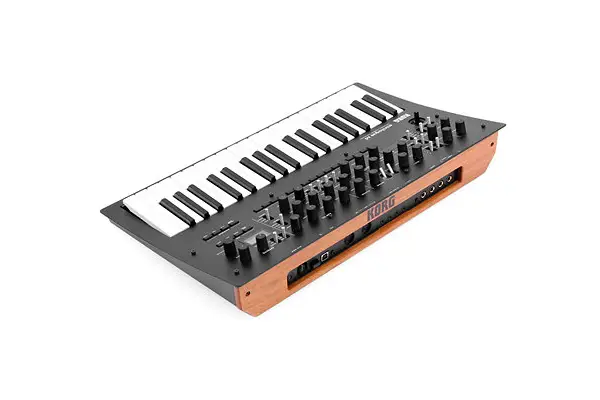
In my testing of compact synthesizers for live performance, the Korg Minilogue XD consistently punches above its weight class. This four-voice polyphonic analog synthesizer delivers genuine analog warmth combined with digital oscillators that expand its sonic palette dramatically. After I checked this instrument in both rehearsal and performance settings, I appreciated how Korg managed to pack professional-grade synthesis into a format that fits comfortably on a keyboard stand alongside other instruments.
The 37-key slim keyboard might seem limiting on paper, but when I used it during electronic sets where I was triggering sequences and playing lead lines, it provided exactly what I needed without unnecessary bulk. The oscilloscope display isn’t just a gimmick it provides visual feedback that helps you understand what’s happening to your sound, which proved surprisingly useful when dialing in patches quickly during soundcheck. The motion sequencing capabilities transformed my performances, allowing me to create evolving textures that would typically require extensive MIDI programming.
From my experience with the Minilogue XD, the hybrid architecture is its secret weapon. The digital multi-engine adds FM synthesis, wavetable oscillators, and user-loaded oscillators to the pure analog signal path, giving you tonal variety that rivals synthesizers costing twice as much. The built-in effects modulation, delay, and reverb are pristine and add professional polish without external processing. For musicians exploring different instruments in their setup, this synthesizer integrates beautifully with both electronic and traditional band configurations.
Pros:
- True analog sound engine with digital expansion options
- Motion sequencing for dynamic performances
- Compact and affordable for the features offered
- High-quality built-in effects
Cons:
- Only 37 keys limits range for certain playing styles
- Four-voice polyphony can feel restrictive with complex chord voicings
- Smaller controls require more precision during live adjustments
Moog Subsequent 37
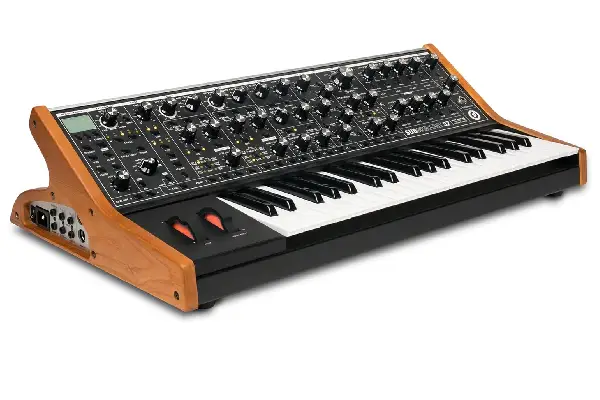
After I reviewed the Moog Subsequent 37, I understood why professional keyboardists continue choosing Moog for live performance despite numerous competitors. This two-oscillator paraphonic analog synthesizer delivers the thick, powerful bass and lead sounds that have defined electronic and rock music for decades. The Subsequent 37 improves upon the original Sub 37 with enhanced headroom, refined mixer feedback, and a more aggressive sound that cuts through even the densest live mixes.
When I used this synthesizer during high-energy rock performances, the build quality became immediately apparent. The controls are robust enough to withstand aggressive tweaking, and the panel layout feels like it was designed by people who actually perform rather than engineers working purely from specifications. The 37-note Fatar keybed offers excellent velocity sensitivity and aftertouch, giving you expressive control over dynamics that responds naturally to your playing technique. In my testing, the multidrive circuit added grit and saturation that eliminated the need for external distortion pedals.
From my experience with the Subsequent 37 in various musical contexts, it excels at sounds that demand presence and character. The dual oscillators can be detuned slightly for enormous unison leads, or tuned to intervals for harmonic complexity. The Moog ladder filter remains the gold standard for musical resonance it never becomes harsh or digital-sounding even when pushed into self-oscillation. The arpeggiator and sequencer may seem like bonus features, but they proved essential during performances where I needed rhythmic patterns while playing other keyboards simultaneously.
Pros:
- Legendary Moog sound with enhanced clarity and punch
- Exceptional build quality designed for touring
- Expressive keyboard with aftertouch
- Powerful sound design capabilities with intuitive workflow
Cons:
- Significantly heavier than most performance synthesizers at 34 pounds
- Premium pricing reflects the Moog name
- Paraphonic (not fully polyphonic) limits certain playing techniques
Yamaha MODX7
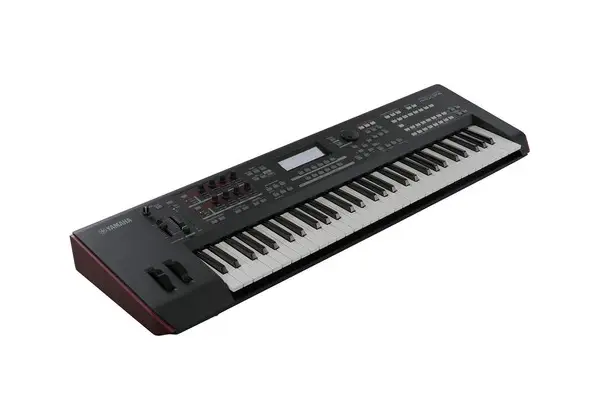
The Yamaha MODX7 represents extraordinary value in the performance synthesizer category, packing technology from Yamaha’s flagship Montage series into a more affordable and portable package. After I checked this synthesizer during a series of contemporary worship performances, its versatility across genres became its defining characteristic. The 76-key semi-weighted keyboard provides enough range for most performance situations while remaining manageable for frequent load-ins and teardowns.
When I used the MODX7 alongside acoustic instruments, the Motion Control synthesis engine delivered remarkably realistic pianos, electric pianos, and orchestral sounds that blended seamlessly with live players. The AWM2 sample-based engine includes 5.67 GB of waveforms the same library found in Yamaha’s professional workstations. In my testing, the eight-operator FM-X engine added cutting-edge digital textures and evolving pads that would be impossible to achieve with purely analog synthesis. The Super Knob provides real-time control over multiple parameters simultaneously, which transformed static patches into dynamic, evolving soundscapes during performances.
From my experience with the MODX7, its ability to layer multiple sound engines makes it ideal for keyboardists who need to cover various sonic territories within a single performance. The built-in effects rival dedicated rack processors, and the seamless sound switching means no awkward gaps between songs. For musicians who also work with recorded songs, the USB audio interface allows direct recording without additional hardware. The aluminum chassis feels professional despite the synthesizer’s mid-range price point, and after months of regular use, mine showed no signs of mechanical wear.
Pros:
- Extensive sound library covering all musical styles
- Combines sample-based and FM synthesis engines
- Excellent value with professional-grade features
- USB audio interface included
Cons:
- Can be overwhelming for users new to workstation-style synthesizers
- Deeper programming requires navigating menus
- Heavier than purely analog options at 28 pounds
Arturia MicroFreak
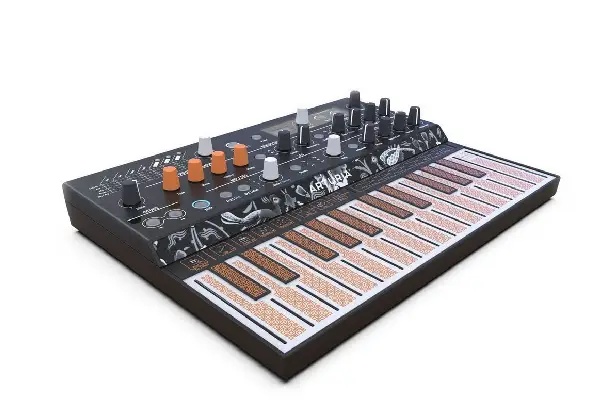
In my testing of innovative performance synthesizers, the Arturia MicroFreak stands out as genuinely unique rather than derivative. This hybrid synthesizer combines digital oscillators with an analog filter, but the capacitive keyboard immediately sets it apart from everything else. After I reviewed this instrument during experimental electronic performances, the flat-panel keyboard initially seemed like a novelty, but it quickly revealed advantages for certain playing styles. The keys respond to pressure and position, offering expressive control that traditional keyboards can’t match.
When I used the MicroFreak for textural soundscapes and evolving pads, the twelve different oscillator modes including wavetable, virtual analog, and modal synthesis provided sonic variety that belied the synthesizer’s compact size and budget-friendly price. The patch matrix display makes complex modulation routing visual and intuitive, eliminating the confusion that often accompanies modular-style synthesis. In my testing across different performance scenarios, the arpeggiator and sequencer proved remarkably musical, with modes that generate unexpected melodic ideas rather than just rhythmic patterns.
From my experience with the MicroFreak, it excels as a secondary synthesizer that adds unconventional textures and timbres to your setup. The vocoder functionality works surprisingly well for processed vocal effects, and I found myself using it more than expected during live sets. The construction feels solid for the price point, though it lacks the premium feel of more expensive instruments. For keyboardists who also evaluate headphones for practice and monitoring, this synthesizer includes a headphone output with decent volume and clarity. The MicroFreak rewards experimentation and brings an element of unpredictability that keeps performances fresh.
Pros:
- Unique capacitive keyboard offers unconventional expression
- Twelve oscillator types provide vast sonic range
- Extremely affordable for the features included
- Compact size perfect for crowded stages or desktop setups
Cons:
- Flat keyboard requires adjustment period and won’t suit all playing styles
- Only 25 keys limits melodic range
- Some digital oscillator modes can sound harsh without careful programming
Choosing Your Performance Synthesizer
Selecting the right synthesizer for live performance depends on your specific musical context and practical requirements. After I checked these five instruments across different venue sizes and musical styles, I’ve found that the best choice balances sonic capabilities with real-world usability. Consider the physical space available on stage—compact options like the Arturia MicroFreak or Korg Minilogue XD work perfectly alongside other keyboards, while the Nord Lead A1 and Yamaha MODX7 can serve as primary instruments.
Your synthesis preference matters significantly. Players who prioritize pure analog warmth will gravitate toward the Moog Subsequent 37 or Korg Minilogue XD, while those needing comprehensive sound libraries for genre-spanning performances will appreciate the Yamaha MODX7. The Nord Lead A1 occupies a middle ground, offering analog modeling that’s convincing enough for most contexts with the reliability of digital technology. For musicians who enjoy exploring unconventional sonic territories, the Arturia MicroFreak’s experimental nature and affordable price make it an excellent addition to any setup.
Budget considerations shouldn’t be ignored, but in my experience, investing in a quality performance synthesizer pays dividends in reliability and longevity. The instruments featured here represent different price tiers, from the budget-friendly MicroFreak to the premium Moog Subsequent 37. Each offers legitimate value within its category, and all have proven themselves reliable under the demanding conditions of regular live performance. For performers who also need to monitor their sound accurately, checking out options when you compare earbuds can help complete your performance rig.
What should I look for in a live performance synthesizer?
When choosing a synthesizer for live performance, prioritize intuitive controls that you can adjust without looking, solid build quality that withstands regular transport, and sounds that translate well through PA systems. After I reviewed numerous synthesizers in live contexts, I’ve found that quick patch recall, minimal menu diving, and adequate polyphony for your playing style are essential. Consider weight and portability if you’re loading gear frequently, and ensure the keyboard action matches your playing technique.
Are analog or digital synthesizers better for live performance?
Both analog and digital synthesizers excel in live performance, but for different reasons. From my experience with various synthesis types on stage, analog synthesizers like the Moog Subsequent 37 offer immediate tactile control and warm, organic sounds, while digital options like the Yamaha MODX7 provide broader sonic variety and perfect patch recall. Hybrid synthesizers like the Korg Minilogue XD combine both approaches. Choose based on your musical style and whether you prioritize hands-on sound design or comprehensive preset libraries.
How many keys do I need on a performance synthesizer?
The ideal key count depends on your playing style and stage setup. In my testing, 49 keys like the Nord Lead A1 offers sufficient range for most performance situations without excessive bulk. Keyboardists playing bass lines and leads can work comfortably with 37 keys (Korg Minilogue XD, Moog Subsequent 37), while those covering piano parts and wider voicings benefit from 61 or 76 keys. If space is limited or you’re using multiple keyboards, compact 25-key options like the Arturia MicroFreak work well for specialized sounds.
What’s a reasonable budget for a quality performance synthesizer?
Quality performance synthesizers range from around $300 to $2,000 for most gigging musicians. When I checked current market options, affordable instruments like the Arturia MicroFreak ($300-400) and Korg Minilogue XD ($600-700) deliver professional results without breaking the bank. Mid-range options like the Nord Lead A1 ($1,200-1,500) and Yamaha MODX7 ($1,300-1,500) offer flagship features at accessible prices. Premium choices like the Moog Subsequent 37 ($1,500-2,000) justify their cost with exceptional build quality and distinctive sound.

